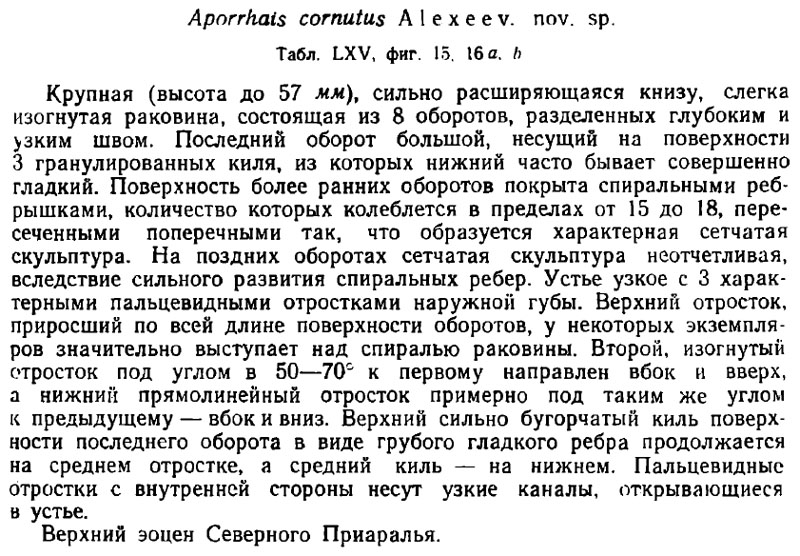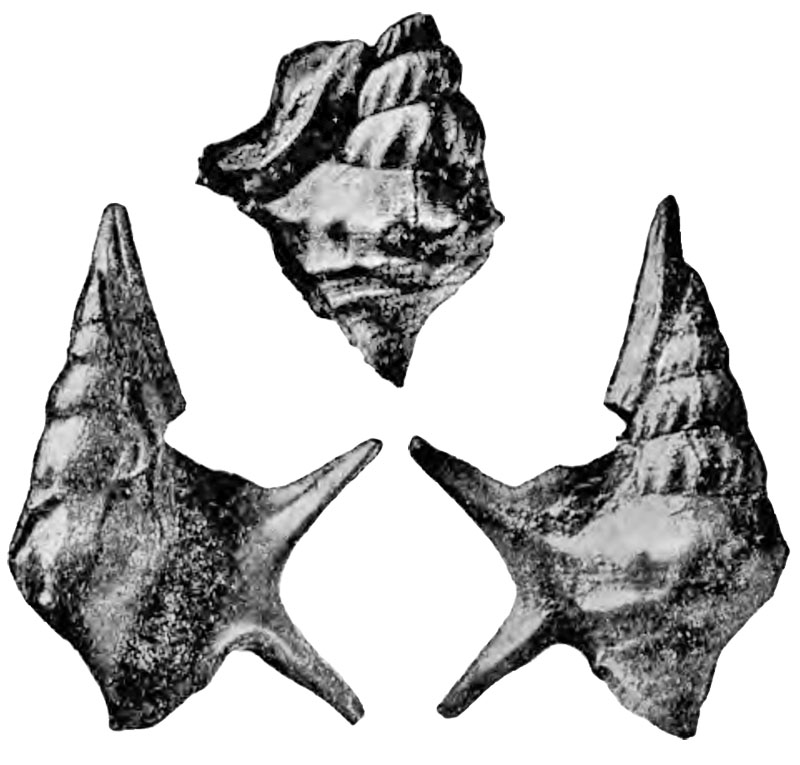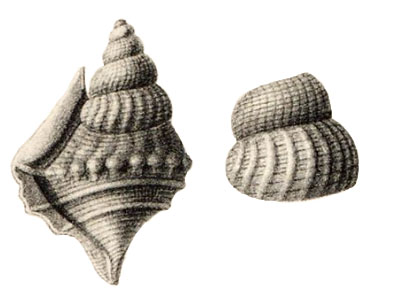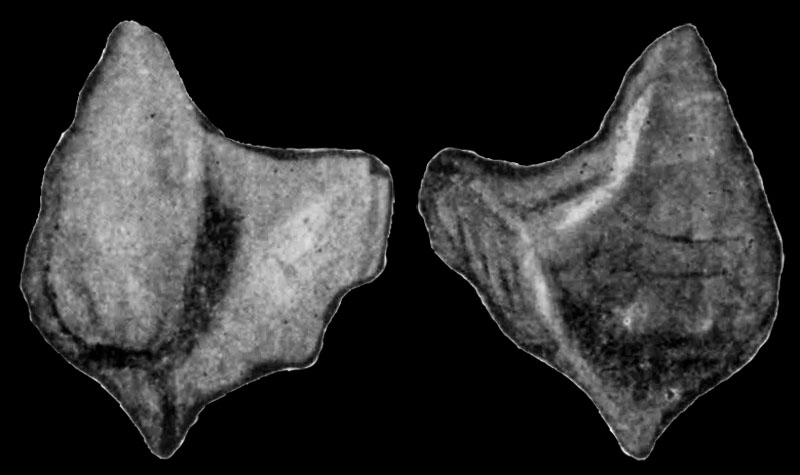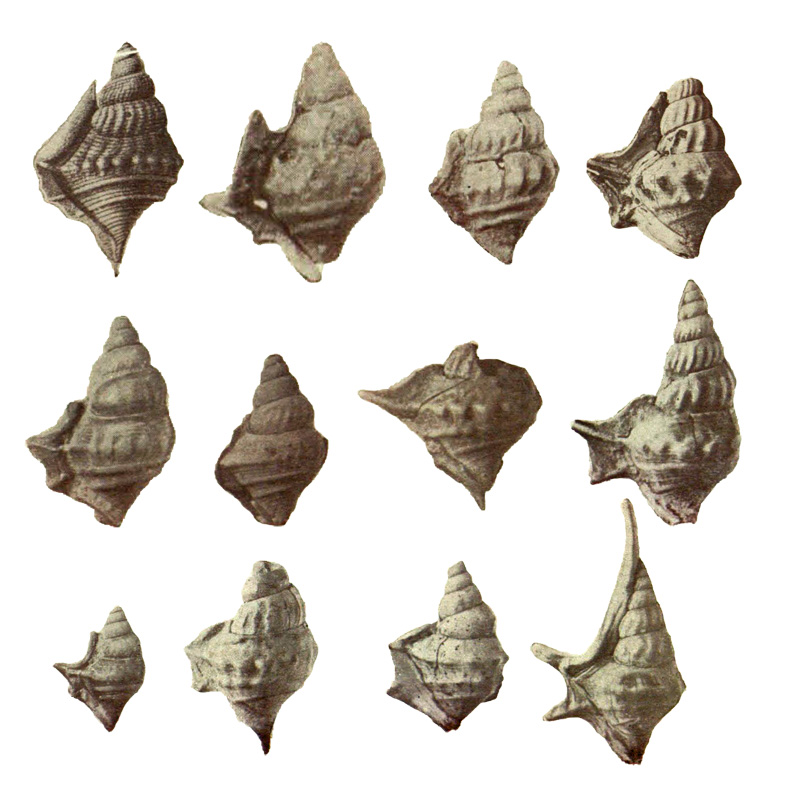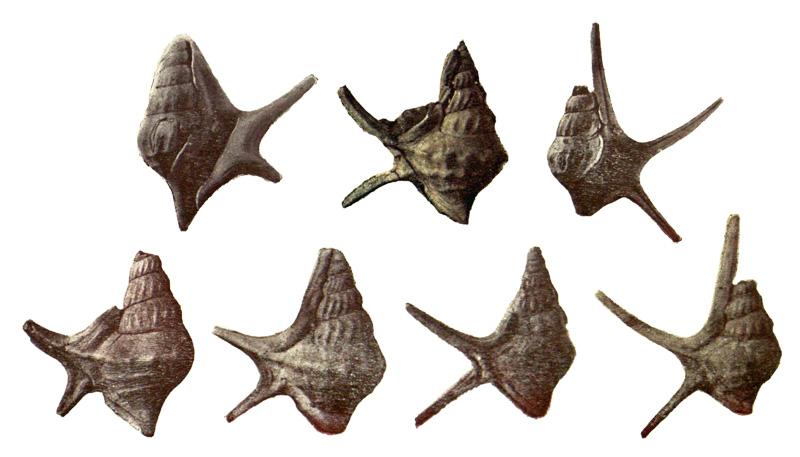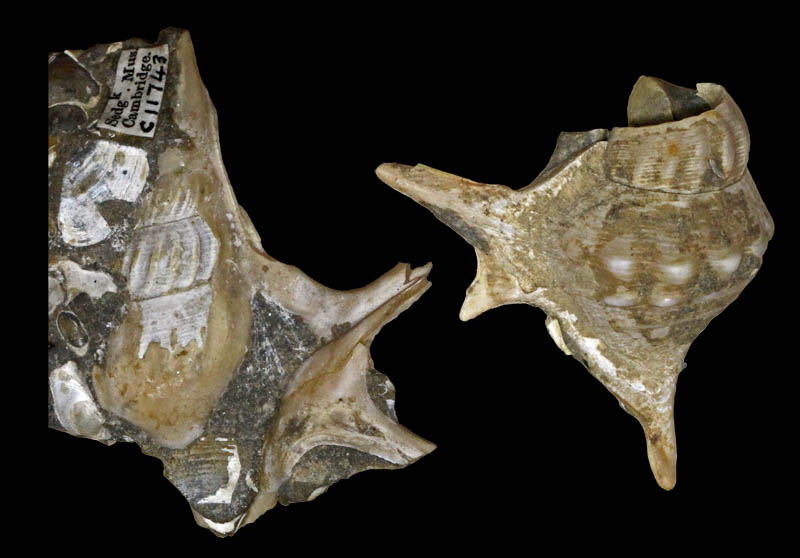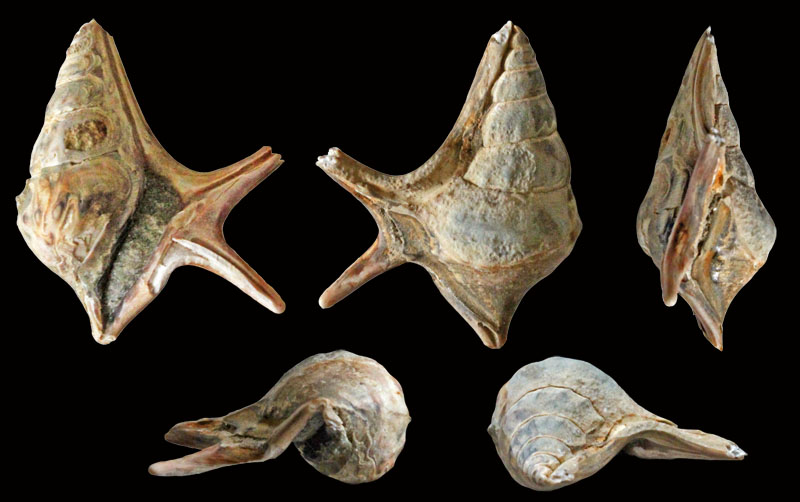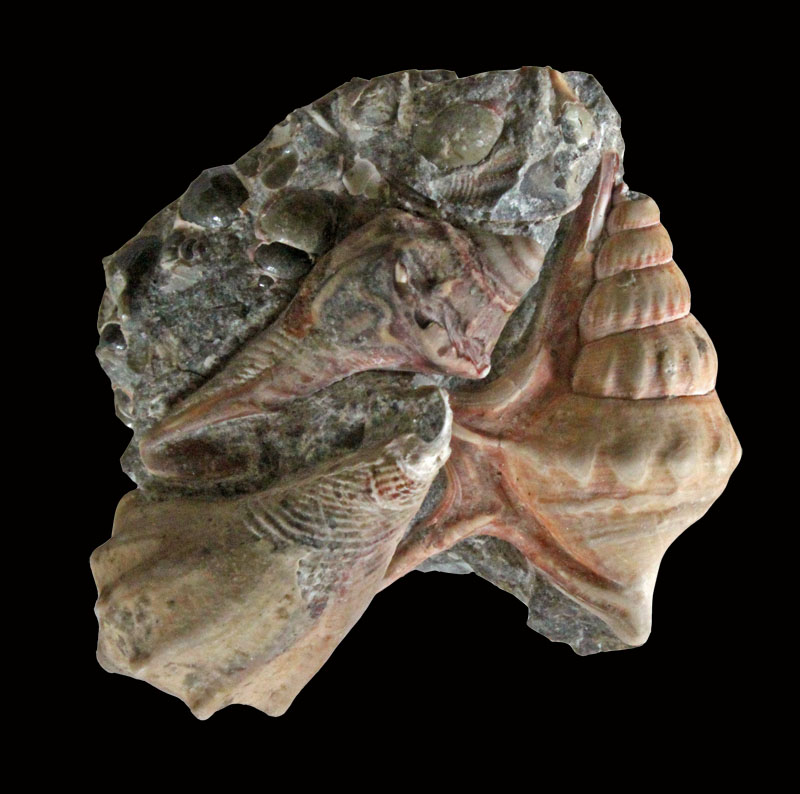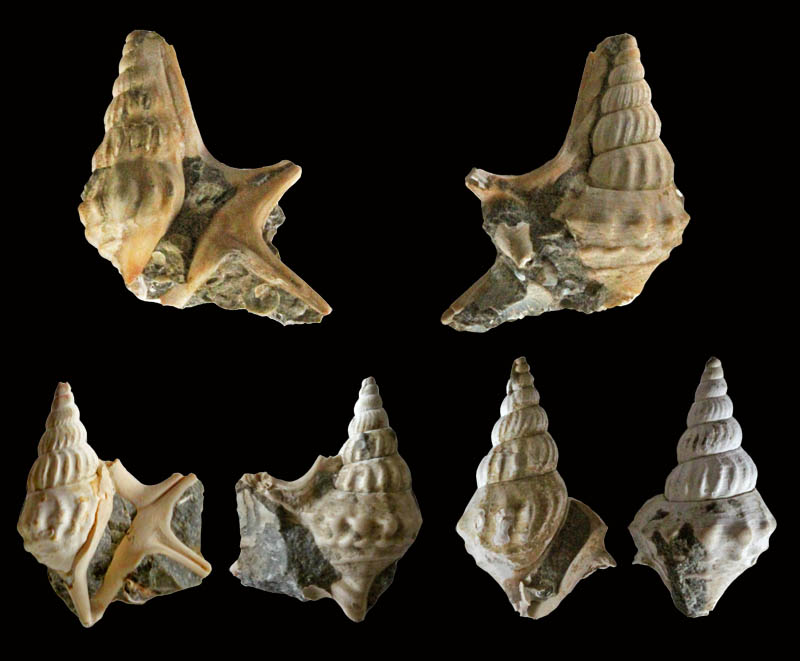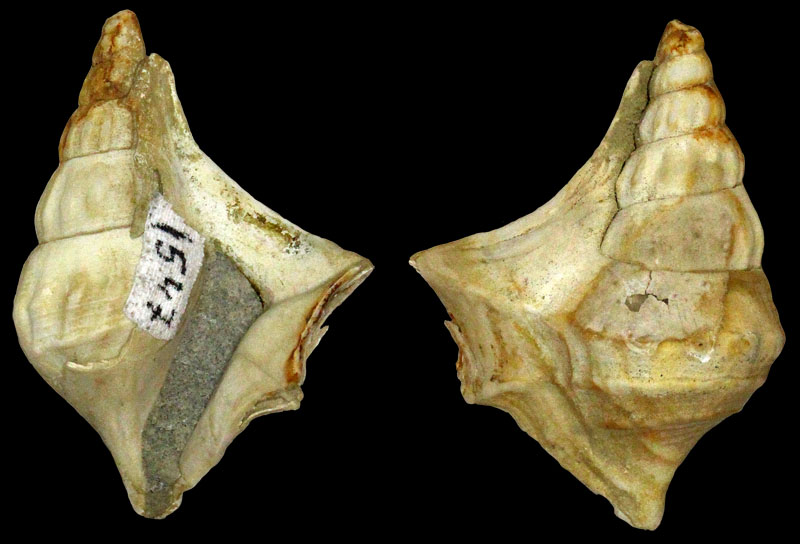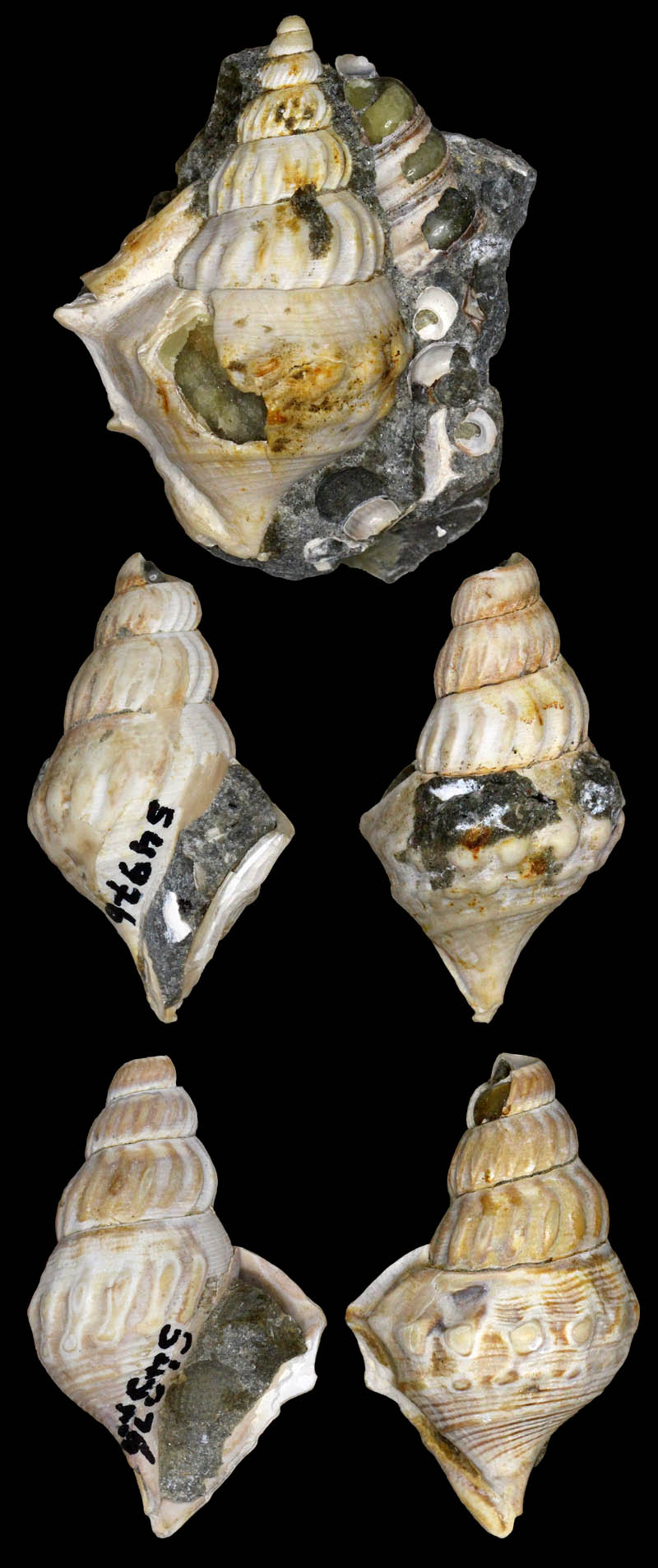|
edit SideBar
|
Species / Aporrhais Cornutus
Stromboidea
Comment:
- should be Aporrhais cornuta
Original Description of Aporrhais cornutus by Alekseev in Korobkov, 1949, p. 244:
Aporrhais cornutus Alekseev in Korobkov, 1949, pl. LXV, fig. 15, 16a, b
Remark: The publication Dates seems to be different: Kafanov, 2002 cited "Korobkov (1949)" as "Korobkov (1949 [1959])".
History and Synonymy
1858
Rostellaria sowerbyi in Abich, 1858, pl. III [in plate caption: II], fig. 1a, b
Description and comment of Abich, 1858, p. 537 about Rostellaria sowerbyi:
- "Da auch von diesem Fossile Exemplare in grosser Anzahl aus der Schicht d. vorhanden sind, so war eine genaue vergleichende Analyse aller Theile thunlich; sie hat gezeigt, dass die wahre Rostellaria Sowerbyi des englischen Horizontes mit beinahe völlig unveränderten Charakteren bis zum Aral geht. Das: anfractibus nodosis longitudinaliter plicatis, plicis obliquis, ab una ad alteram suturam extensis ist eben so bestätigt wie das penultimo anfractu subtuberculato; ultimo tuberculato-tricarinato; rostro brevi acuto. Die etwas grobe, aber richtige Abbildung zeigt das Fossil in doppelter Vergrösserung. In der Beschreibung der norddeutschen Tertiär-Versteinerungen führt Beyrich auf Grund der von Philippi gezeigten zoologischen Nothwendigkeit, die dem miocänen Strombus pes pelicani verwandten Arten von den übrigen Rostellarien Lamarks in trennen, mehrere Rostellarien als Aporrhaisarten auf und ordnet, um Fehlschlüssen über die geologische Bedeutung der vorhandenen Verschiedenheiten vorzubeugen, zwei besonders hervortretende Varietäten, A. speciosa und A. alata, nach ihren Vorkommen. Die Schilderung welche sehr genau, in die Sculpturverhältnisse dieser unter sich unverkennbar durch leise Uebergänge verbundenen Arten eingeht, lässt nebst den Abbildungen kaum einen Zweifel, dass die A. speciosa, pag. 493. Taf. XI, fig. 1 bis 6 der citirten Abhandlung aus dem unteren miocänen Terrain des nordwestlichen Deutschlands wirklich mit der am Aral vorkommenden Art übereinstimmt. Wo sich einige Abweichungen in der Analyse der Form bei Beyrich von der Aralart zeigen, scheinen sie unwesentlich und kaum die Gränzen der Varietäten zu überschreiten, welche durch Abbildungen nachgewiesen und vergleichbar gemacht worden. Indessen dürfen einige constante Unterschiede der Sculptur zwischen der deutschen Aporrhais und der asiatischen nicht unberücksichtigt bleiben. Die Querstreifen der ersteren sind immer feiner; auch habe ich bei der Aralart auf keinem als dem oberen Kiel des unteren Umganges Höcker bemerken können, die bei der A. speciosa auf allen 3 Kielen zugleich vorkommen können. Ein andrer Unterschied von grösserem Belang ist jedenfalls der, dass die Querstreifen, welche die ganze Oberfläche der Schlusswindung auf der Art vom Aral bedecken, doppelter Natur sind, indem immer eine sehr feine mit einer doppelt so starken abwechselt, ein Verhältniss, weiches bei der A. speciosa nicht vorkommt. Da auch Nyst nichts von diesem Verhältniss von Querstreifen zweifacher Natur bei der R. Sowerbyi erwähnt, so kann die Identität der Aralart mit einer bis jetzt bekannten doch wohl nur bedingungsweise gelten. Die R. Sowerbyi wird von d'Orbigny in die étage falunien, von Nyst aber in das syst. tongrien gestellt. Von der eocänen R. pescarbonis aus Roncà sagt Brongniart sehr bestimmt: des tours de spire ne sont point carénés, mais marqués de côtes longitudinales, qui semblent étre les tubercules alongés. Mem. sur les terr. de sedim. sup. calcareo trappéens du Vicentin. pag. 75, Tab. IV, fig, 2, a, b."
1958
Aporrhais (Chenopus) cornutus var. Klyushnikov, 1958, pl. 34, fig. 9
- Loc.: Mandrykovka, Ukraine
- Comment Wieneke: This specimen belongs to the A. speciosa/margerini complex.
1963
Description of Chenopus cornutus Alekseev, 1963
Types:
- CNIGR no. 111/3952 (pl. XV, fig. 6)
- CNIGR no. 112/3952 (pl. XV, fig. 7)
- CNIGR no. 113/3952 (pl. XV, fig. 9)
- CNIGR no. 114/3952 (pl. XV, fig. 13)
- CNIGR no. 115/3952 (pl. XV, fig. 11)
- CNIGR no. 116/3952 (pl. XV, fig. 14)
- CNIGR no. 117/3952 (pl. XV, fig. 10)
- CNIGR no. 118/3952 (pl. XV, fig. 15)
- CNIGR no. 119/3952 (pl. XV, fig. 16)
- CNIGR no. 120/3952 (pl. XV, fig. 8)
- CNIGR no. 121/3952 (pl. XV, fig. 12)
- CNIGR no. 122/3952 (pl. XVI, fig. 5)
- CNIGR no. 123/3952 (pl. XVI, fig. 7,11)
- CNIGR no. 124/3952 (pl. XVI, fig. 6)
- CNIGR no. 125/3952 (pl. XVI, fig. 9)
- CNIGR no. 126/3952 (pl. XVI, fig. 10)
- CNIGR no. 250/3952 (pl. XVI, fig. 8)
Chenopus cornutus in Alekseev, 1963; Pl. XV, no. 5-16.
- First row: 1,2, and 3 from Turangly; last from Ustyurt; Coll. G.V. Bogachev
- Second row: 1,2 and 4 from Turangly; 3 from Kyzyl-Dzhar
- Third row: 1,3 and 4 from Turangly; 2 from Kyzyl-Dzhar
- All from Northern Aral, Kazakhstan
Chenopus cornutus in Alekseev, 1963; Pl. XVI, no. 5-10.
- Upper row: from Turangly, Northern Aral, Kazakhstan
- Lower row: left; Northern Ustyurt, Northern Aral, Kazakhstan; others from Turangly, Northern Aral, Kazakhstan; Coll. M. Prigorovsky
Specimens from institutional collections
Aporrhais sowerbyi, Eocene; Turanghul, N shore of Aral Sea, Kazakhstan, Coll. Sedgwick Museum of Earth Sciences, University of Cambridge C11743-4
- ©2022. Sedgwick Museum of Earth Sciences, University of Cambridge. Reproduced with permission. This work is licensed under a Creative Commons Attribution-NonCommercial-ShareAlike 3.0 Unported License
- Lukovitch, M.T. 1921, p. 159:
- "The account of the fauna from the Tertiary Beds of the Aral Sea given in the following pages, is based on the collection of Mr. W. Batesen. In 1886 he visited the whole northern shore between the Perovski Gulf, the mouth of the Syr-Daria, and lake Chalkar, for the purpose of making scientific investigations. On this journey he collected a large number of well preserved fossils from several localities of this area, viz.: Togus-Ken, Turanghul, Termenbes, Perovski Gulf, Kum-Bar-Sai. Togus-Ken is about ten miles north of the shore of the Paskevich Gulf, and about 29 miles W. of Turanghul.*) Kum-Bar-Sai is a valley on the north-west shore of Lake Chalkar. Tol-Sai is about 50 miles N. E. of the town of Irghiz, in the direction of Chalkar. The greater part of the collection was presented by Mr. Bateson to the Sedgwick Museum, Cambridge, and the rest to the British Museum (Natural History Department)."
Specimens from private collections
Aporrhais cornutus Alekseev, 1963; upper Chegan Formation, Priabonian, upper Eocene; W. Aral Sea, Kazakhstan; Coll. Elmar Mai
Aporrhais cornutus Alekseev, 1963; upper Chegan Formation, Priabonian, upper Eocene; W. Aral Sea, Kazakhstan; Coll. Elmar Mai
Aporrhais cornutus Alekseev, 1963; upper Chegan Formation, Priabonian, upper Eocene; W. Aral Sea, Kazakhstan; Coll. Elmar Mai
Aporrhais cf. cornutus Alekseev, 1963; upper Chegan Formation, Priabonian, upper Eocene; Chernyshev Bay, N-W Aral Sea, Kazakhstan; Coll. Ulrich Wieneke
Aporrhais cf. cornutus Alekseev, 1963; Baikalsee Formation(?), Miocene(?); Usturt, Kazakhstan; Coll Stichting Schepsel Schelp SSS54976
References:
- Abich, O.W.H. von 1858. Beiträge zur Paläontologie des asiatischen Russlands; Mémoires de l’Académie des Sciences de Saint-Petersbourg. Sciences mathématiques et physiques, 6 (7): 537-577, pl. 1-8. [also St. Petersburg :Buchdruckerei der Kaiserlichen Akademie der Wissenschaften, 1858,] Fulltext
- Alekseev A.K. (1963) - Paleogene molluscs of the Northern Aral region (in Russian)
- CNIGR-Holotypes
- Kafanov, A.I. 2002. Recent and fossil Clinocardiinae (Bivalvia, Cardiidae) of the World. VI. Genus Ciliatocardium Kafanov, 1974 (part II); Bulletin of the Mizunami Fossil Museum, no. 29(2002), p. 1-18, Fulltext
- Klyushnikov,M.N., 1958. Stratigraphy and fauna of the lower Tertiary deposits of Ukraine. Transactions of the Institute of Geological Sciences of the Ukrainian Academy of Sciences, Kiev, pp. 1-455.
- Korobkov, I.A. 1949 [1959]. Class Gastropoda in A.N. Ryabinin & A.I. Korobkov (eds.), Atlas rukovodyashchikh form iskopaemÿkh faun SSSR [Atlas of the guide forms of the fossils faunas of the USSR]. vol. XII. Paleogene. "Gosgeolizdat" Publ. House, Moscow
- Lukovitch, M.T. 1921. A new contribution to the knowledge of the Lower Tertiary Mollusca of the Aral Sea, Société des sciences naturelles croate 33: 157-174, URL: https://www.biodiversitylibrary.org/page/11244640
- Lukovitch, M. T. (1926). The Eocene Molluscan Fauna from the Area between the Aral Sea and Lake Chalkar and its Importance. Ann. géol Pén. balkan, 8, 19-82.
|

